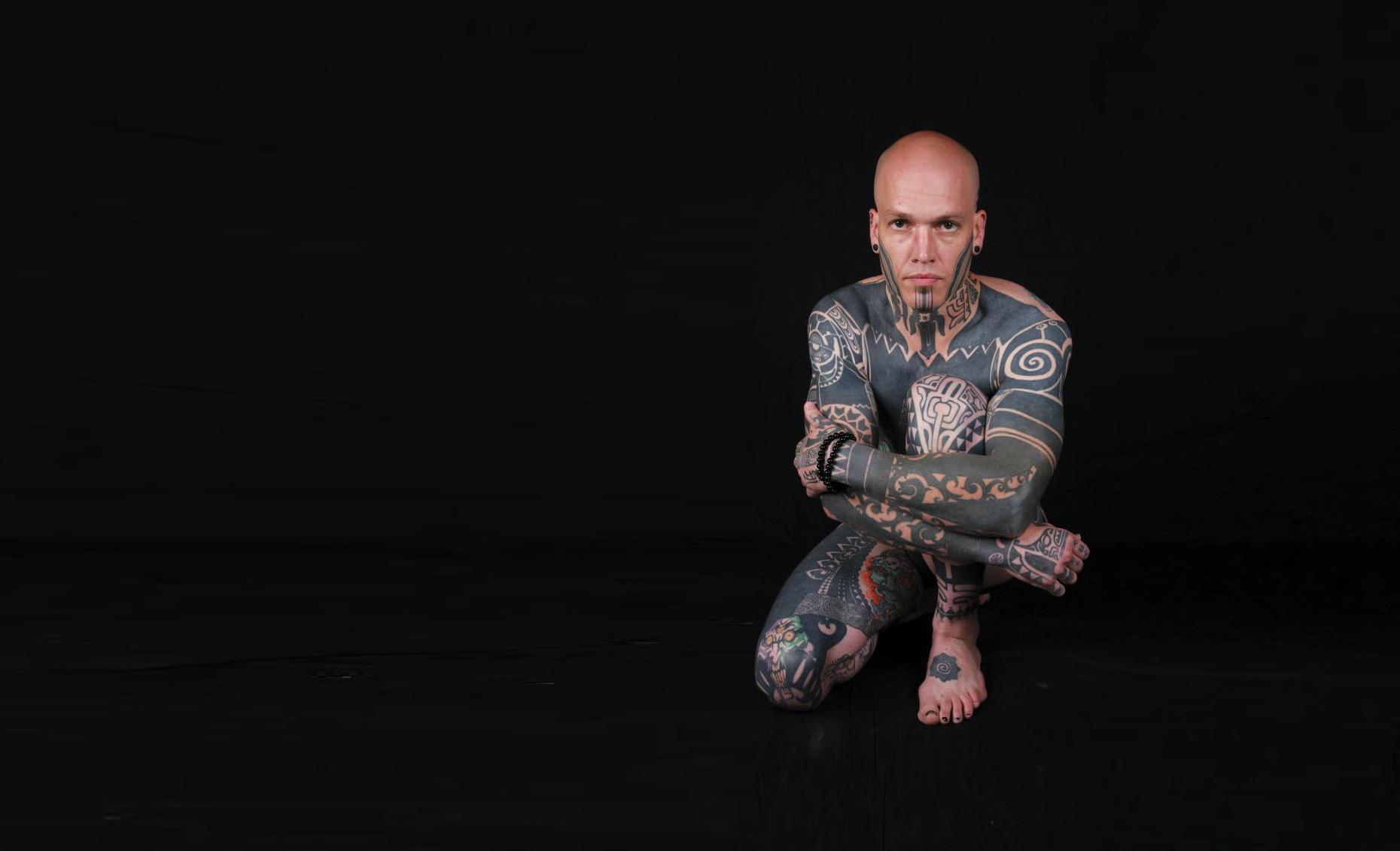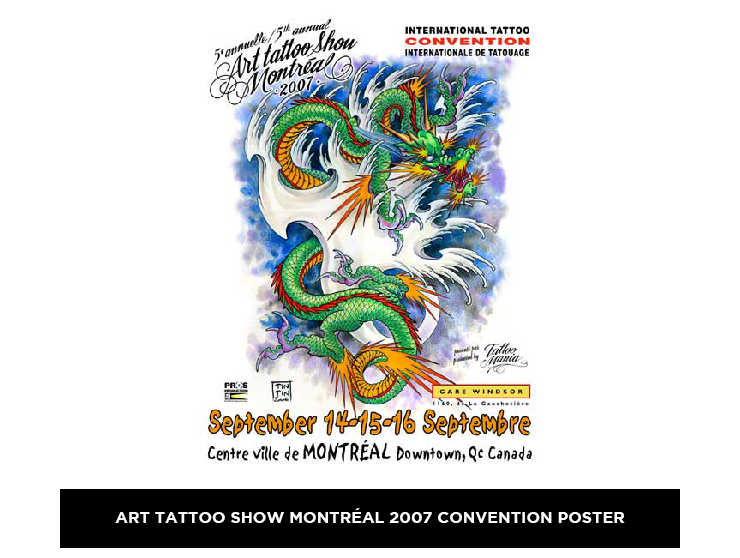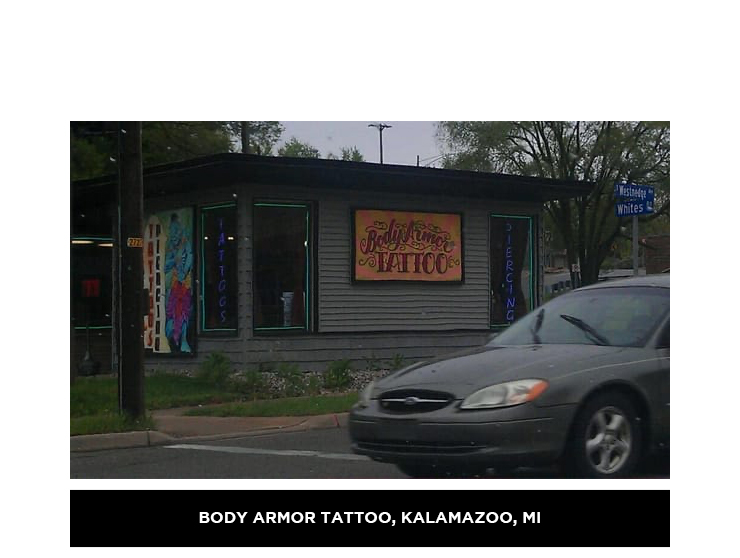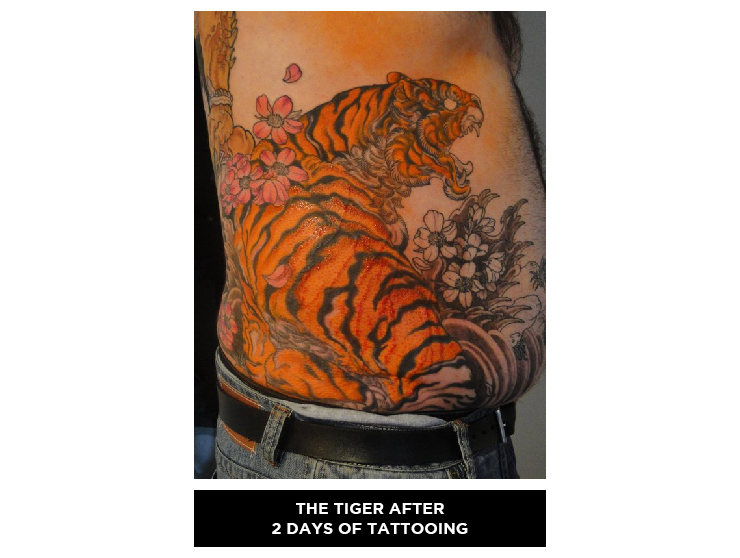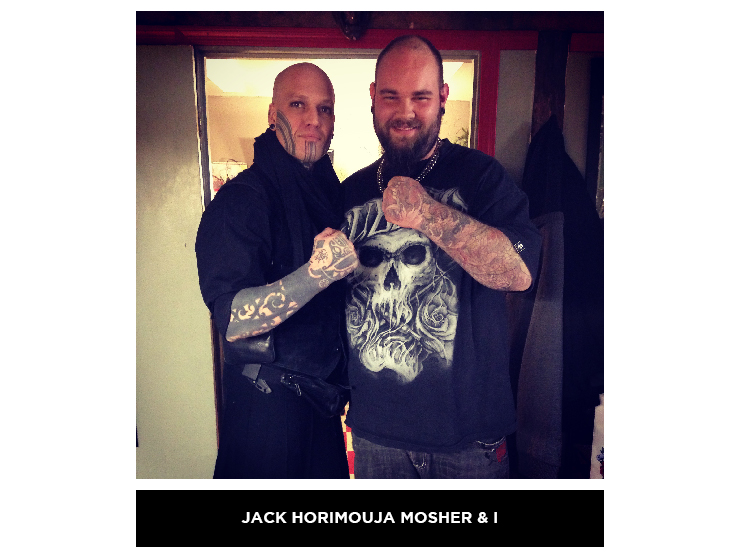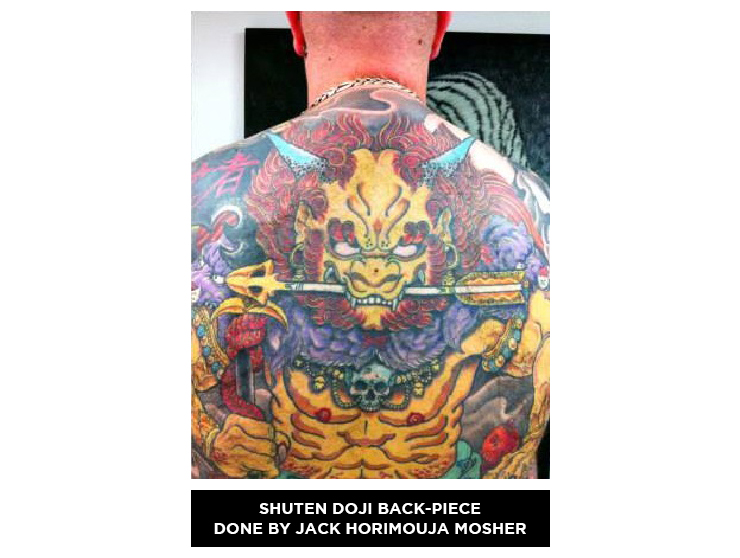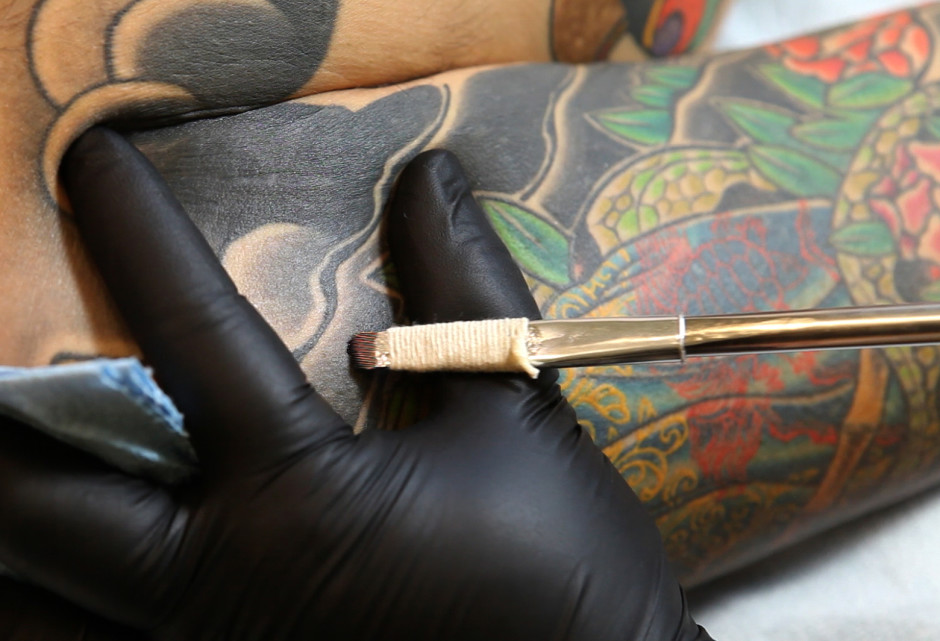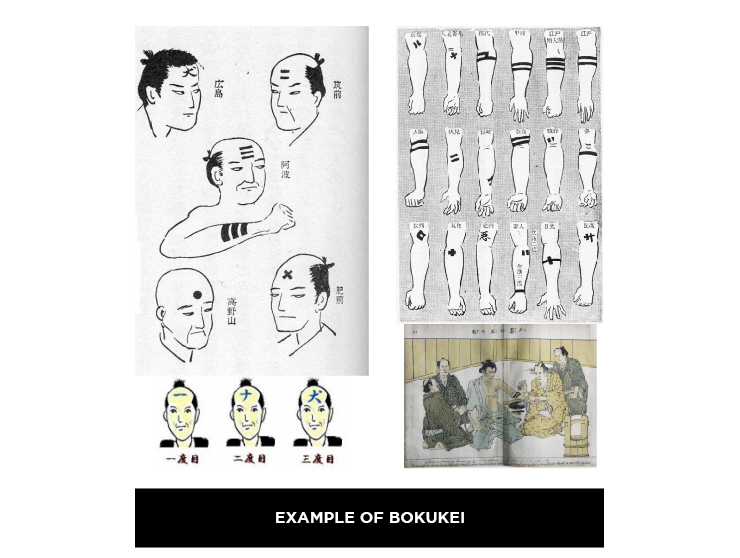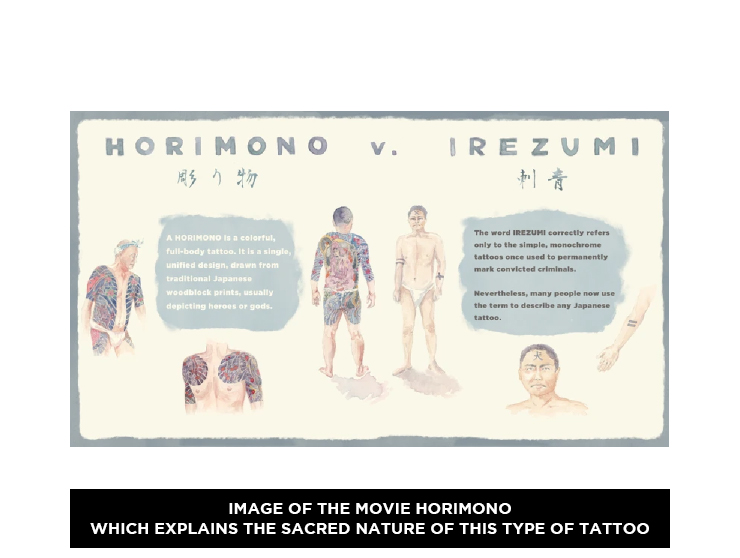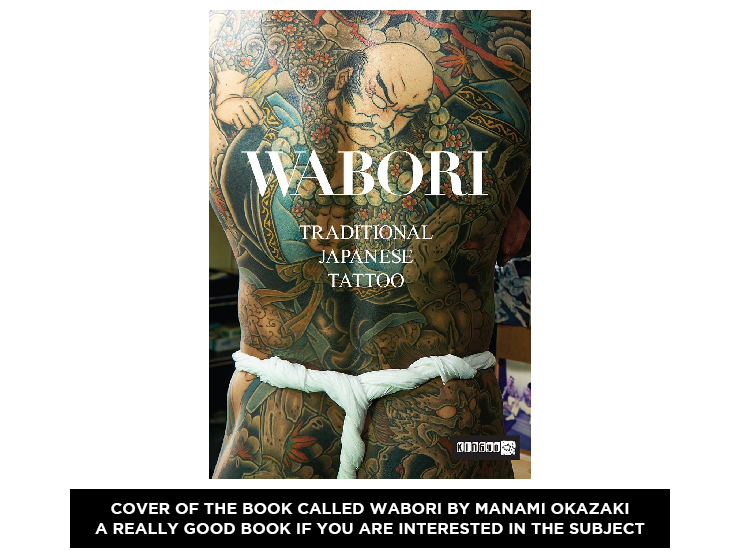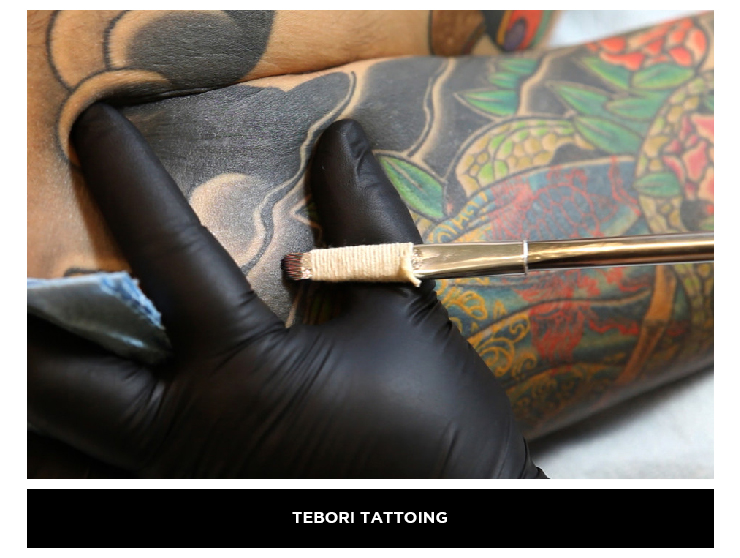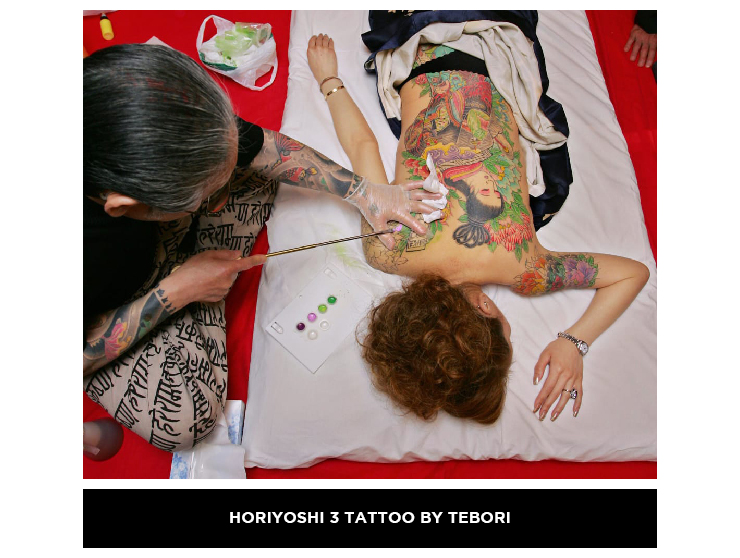Jack (Horimouja) Mosher – My back-piece done in 2 months
Jack (Horimouja) Mosher – My back-piece done in 2 months
The first time I visited a tattoo convention was the Art Tattoo Show of Montreal in 2007. I was fascinated; I passed hours looking at everything and I spent all the money I had to buy 2 books by Horimouja:
- 100 Japanese Tattoo Designs part II
- Bloody Japanese Prints
These books cost me 300$ which was a lot for someone working part-time at the minimum wage as a wrapper in a supermarket. I spent days studying and observing every drawing, every line. I decided there and then that one day I was going to get tattooed by Jack Mosher.
Fast-forward to 2009; I made an appointment to get tattooed at Body Armor Tattoo, his studio in Kalamazoo (MI). It was a 12-hour drive to get there. I went with my girlfriend, Virginie and my childhood friend, Patrick. A great road trip to get tattooed by one of my idols! I was exited and nervous.
I wanted a tiger on my ribs with a little rabbit at the bottom. When I arrived to my appointment, I was surprised to see that he didn’t prepare a drawing. He explained to me that he always did his design free hand. He then took a sharpie and started to draw directly on my skin. I was fascinated to see him working without a stencil! I knew his talent for drawing, so I wasn’t stressed at all about the result, I trusted his skills. I got tattooed 2 days straight and the result was better than what I had expected.
I really appreciated my time spent in Michigan. Watching Jack work and talking with him made me realize how much I could learn from him. I decided to let him do my back-piece, the biggest canvas on the body.
By chance Jack told me he was moving to Erie in Pennsylvania which was great because that meant he was living closer to me (8-hour drive instead of 12)! We scheduled a meeting to start the back-piece. I was hesitant between getting a back-piece of Taira no Tomomori, the valorous samurai, or Shuten Doji, king of the demons. I let Jack choose and he decided to go with Shuten Doji because it’s a less common subject.
Thanks to Shuko, Jack’s Japanese wife, he managed to incorporate multiple elements of the classic story of Shuten Doji. On top of that, my back-piece has a lot of hidden symbols:
- In the axe, we can read the kanjis 亡者, which are pronounced ‘’Mouja’’. Like in Jack Hori-mouja, which actually means dead alive or zombie. I now have his signature in my tattoo.
- He is wearing tiger skins on his shoulder, which references the traditional Japanese-time system. Shuten Doji would come out at the hour of the tiger (between 3:00 AM and 5:00 AM) to go hunting for his preys.
- Some jewelry has a fleur-de-lys design, which references my Quebec origins.
We had 3 months to finish my back-piece since Jack was moving to California because he had been offered a job at High Voltage (Kat Von D’s tattoo parlor). Therefore, with a lot of motivation, of sweat, and blood, we managed to finish my back-piece in 2 months in a half, even though there was an 8-hour drive between Jack and I.
Each week, I would leave Sunday at 6:00 PM after my shift in a tattoo parlor to drive to Erie, PA. I would get tattooed on Monday, Tuesday and Wednesday. I would leave Wednesday night and make it back Thursday in time for my shift. More than 60 hours of tattooing has gone inside this tattoo in just a couple of weeks.
For those wondering why I didn’t take a commercial flight to go and see him, I simply didn’t have the money for plane tickets. I preferred putting my money in my tattoo and my learning than in a comfy plane seat.
On top of getting tattooed, I spend a lot of time drawing and talking with Jack. He has one of the largest book collections I have ever seen! I spent hours looking at his books, he even gave me a book! We would spend nights drawing; he would explain different art concepts and show me different techniques. All those hours spent with him are worth so much and I’m truly grateful to have had such an opportunity.
Tebori tattoo 手彫り – Hand Carved Tattoo
Tebori tattoo 手彫り – Hand Carved Tattoo
It is impossible to fully understand Japanese tattoos if one doesn’t understand the Japanese words associated with this practice.
A common misconception is that all tattoos are frowned upon in Japan. This is true only for Japanese people wearing tattoos, they mostly do not really care about outsiders having tattoos. This tattoo snobbism dates a while back, during the Edo period (1600-1868). During those times, tattoos were used to mark criminals of their petty crimes (ex: stealing). Petty crimes would not require a death sentence, but the authorities would mark the criminal with a visible tattoo to warn the population. This type of punishment was called Bokukei. After time, groups of criminals (like the Yakuzas) would seek out tattoo artists to get their bokukei covered by elaborate and beautiful tattoos.
These tattoos were done on criminals to warn the population of their mischief. This punishment was done for petty crimes since the death penalty was very present in ancient times in Japan.
Tattoo artists, called Horishi, started to make complex tattoos with colors and designs. Based on Japanese woodblock prints, they would create a piece of art on the skin of their client. This is where a second word for tattoo came to be: Horimono (which means tattoo).
Today, the word that is most used to design tattoos is Irezumi, which is a general term for tattoo. Irezumi is mostly used to design simple tattoos as Horimono is used to design large and elaborate tattoos.
Here is the link for the movie: https://www.youtube.com/watch?v=q1h8K92cEag
Different reasons explain these different ways of saying the word “TATTOO” in the Japanese language. The main reason is that during the Meiji era (1868-1912), the government made a law stating that tattoos were illegal. This resulted in the criminalisation of the art. Therefore, all the words associated with tattoos (like bokukei, horimono and irezumi) were associated with criminal activities. Event if it has been more than a hundred years, you can still feel the unease of Japanese people when they say these words.
On top of all those different words to say tattoo, there are two different styles of tattoo in Japan. Yobori is used to describe Occidental tattoo done at the machine, while Wabori is used to describe traditional Japanese tattoo done by hand (by Tebori).
Yobori is traditional tattooing like we know it. Done with an electric tattoo machine, this type of tattoo was imported to Japan by Americans. Yobori refers to the classic tattoo styles such as Old School, New School, Neotraditional, etc. everything that refers to the occident.
Wabori was invented in Japan and is what we call Japanese style. Based on woodblock prints and classic Buddhism imageries, wabori regroups everything that is Japanese in a tattoo. Wabori is tarditionnally done by Tebori (by hand).
Before electricity, Tebori was invented during the Edo period by Horishi to cover-up bokukei (punishment tattoos) with elaborate horimonos. Tebori is done by putting needles at the end of a bamboo stick. The ink is inserted in the skin by a thrusting motion done by hand by the Horishi.
Both tattoo styles are practiced in Japan. Some artists simply practice wabori while certain can do both wabori and yobori. This mainly depends on the master and the tattoo family.
Having fewer artists doing tebori tattoos, there are certain myths around this mysterious practice. Some believe that a tattoo done by tebori is magical and protects the wearer because the artist puts his entire self in the tattoo, like a talisman. In Japan, a tattoo done by tebori has a bigger spiritual value than a tattoo done by a tattoo machine.
There seems to be two characteristics that are true surrounding tebori:
- Tebori tattoo is less painful than tattoos done by machine since there are less needles perforating the skin by second.
- Colors tend to stay flashier longer since more pigment is inserted under the skin.
But keep in mind that not every type of tattoo can be done by Tebori. Usually, the tattoo style associated with tebori is Traditional Japanese tattoo because this style has a lot of flashy colors, not a lot of shades and bold lines. It would be impossible to do a portrait by Tebori.
Yes I do tebori !
I do tebori tattoos, but I choose pieces that I know will be better done by tebori than by the tattoo machine. I don’t do everything by tebori.
It’s important to understand also that a tattoo done by Tebori takes more time and is therefore more expensive. For more information or to ask for a Tebori tattoo, you can fill up my online form: www.jftattoo.com
